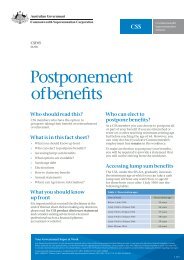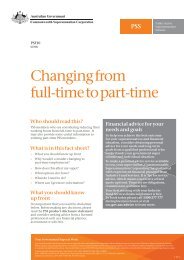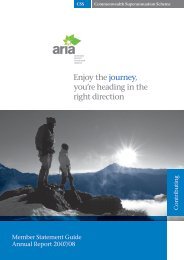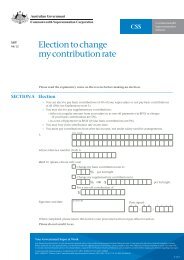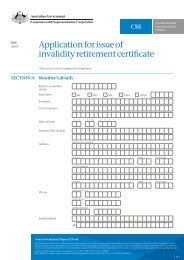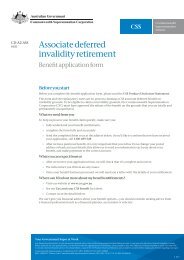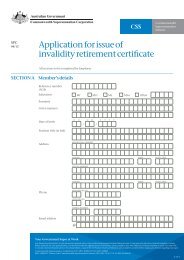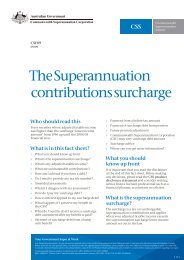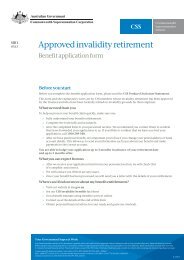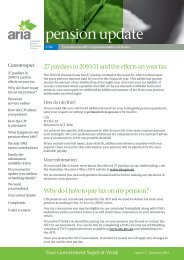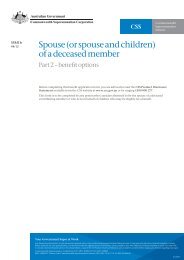The CSS Member Statement Guide
The CSS Member Statement Guide
The CSS Member Statement Guide
You also want an ePaper? Increase the reach of your titles
YUMPU automatically turns print PDFs into web optimized ePapers that Google loves.
Non-disclosure of a medical condition<br />
If CSC believes that you didn’t properly disclose a pre-existing<br />
condition at the time of your medical examination, you or your<br />
dependants may not receive full invalidity or death benefits.<br />
<strong>The</strong> pre-existing condition will be subject to the same considerations<br />
as if it had been specified on your BCC.<br />
Minimum amount on exit<br />
Your minimum amount on exit (MAE) is a dollar amount that is<br />
guaranteed payable regardless of fund performance.<br />
This amount is your account balance at 30 June 2003 plus any<br />
member contributions, productivity contributions, co-contributions<br />
and transfer amounts (not including earnings) paid between<br />
1 July 2003 and 30 June 2007.<br />
We developed the MAE to make sure a previous change in our earning<br />
allocation policy did not retrospectively affect members’ accounts.<br />
Your total equity is affected by fund earnings and your MAE is the<br />
minimum amount payable when you claim your benefit.<br />
Your preservation age<br />
Superannuation law places restrictions on when you can access<br />
superannuation benefits, especially lump sums. One of these<br />
restrictions is called your ‘preservation age’ and it applies in addition<br />
to the other restrictions on withdrawing your benefit.<br />
Generally, you need to have reached your preservation age before you<br />
can access any cash lump sum.<br />
Preservation age<br />
Date of birth<br />
Preservation age<br />
Before July 1960 55<br />
1 July 1960 – 30 June 1961 56<br />
1 July 1961 – 30 June 1962 57<br />
1 July 1962 – 30 June 1963 58<br />
1 July 1963 – 30 June 1964 59<br />
After 30 June 1964 60<br />
Your SIS upper limit<br />
<strong>The</strong> Superannuation Industry (Supervision) Regulations 1994 (SIS) place<br />
certain restrictions on the amount of cash lump sum that can be paid<br />
to members who are not permanently leaving the workforce, or have<br />
not reached their preservation age.<br />
This means if you’re not permanently retiring from the workforce or<br />
have not reached your preservation age, any cash lump sum paid to<br />
you can’t exceed your SIS upper limit. Your SIS upper limit is the cash<br />
amount you would have received if you’d been involuntarily retired<br />
(or retrenched) on 1 July 1999.<br />
Any <strong>CSS</strong> lump sum amount that’s higher than the SIS upper limit<br />
must be rolled over to a rollover fund.<br />
7



